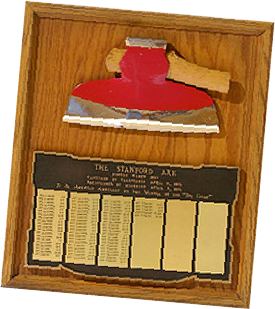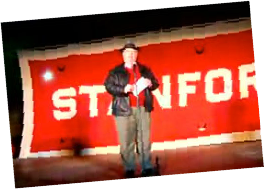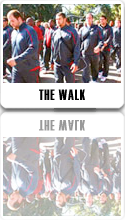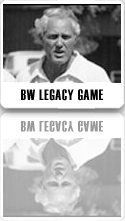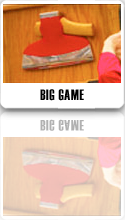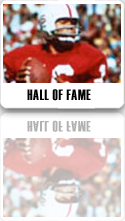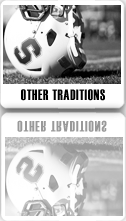
What Stanford and Cal began on March 10, 1892, in San Francisco is now one of the greatest rivalries in college football. The Big Game - Stanford's annual war on the gridiron with the University of California - has now entered its third century.
The first Big Game was held before an overflow crowd of 20,000. Stanford manager Herbert Hoover, later to become the 31st President of the United States, printed 10,000 tickets for the 15,000-seat Haight Street baseball grounds in San Francisco. However, as the crowd filled the stadium, Hoover ran out of tickets and was forced to collect coins at the gate and put them in empty wash tubs and boxes. When the team captains were on the field and the referee asked for the ball, there was one small problem. No one remembered to bring the ball. After the game, Hoover and the Cal manager counted $30,000 in receipts - enough to finance the team for the next season. The Big Game was born.
Stanford leads the all-time series 54-44-11, and has won seven of the last 12 and 11 of the last 18 despite Cal's five consecutive victories. But, it has been a series that has been very close with just 35 points (1735-1700) separating the two teams. The Big Game is tied for the 10th longest rivalry in college football history.
The Big Game has been a series where "anything can happen, and usually does." Five Big Games have been decided on the final play, including the first overtime contest in 2000.
The 1982 game will forever be known as one of the classic contests in college football history, thanks to "The Play." Stanford had taken a 20-19 lead on a 34-yard field goal by Mark Harmon with just four seconds to play. On the ensuing kickoff, Cal scored a touchdown on an incredible five-lateral, 57-yard return that ended when the Bears' Kevin Moen bowled over Gary Tyrell, a trombonist in the Stanford band, adn went into the end zone for a controversial game-winning touchdown.
In 1924, Stanford rallied from a 20-6 deficit to tie Cal's Wonder Team, 20-20. In the 50th Big Game in 1947, winless Stanford (0-8) led the 8-1 Bears, 18-14, before Cal scored on an 80-yard touchdown pass with less than three minutes remaining in the game.
The 1959 classic featured the Bears holdong on to win 20-17 despite an NCAA-record performance by Stanford quarterback Dick Norman, who threw for 401 yards on 34 of 39 passing. Vince Ferragamo's eight-yard TD pass to Steve Sweeney on the game's final play gave Cal a 24-21 Big Game win in 1972. Two years later, Stanford won 22-20 when Mike Langford connected on a 50-yard field goal on the game's final play.
In 1976, Cal's Markey Crane fumbled the ball on his own two-yard line with 1:31 left in the game and his team on top, 24-19. Stanford's Ron Inge scored the game-winning TD moments later to give the Cardinal a 27-24 win. Tuan Van Le blocked a 20-yard field goal in the 1988 Big Game to preserve a 19-19 tie.
Stanford's answer to The Play occurred in 1990 when the Cardinal scored nine points in the final 12 seconds to pull out an improbably 27-25 victory. QB Jason Palumbis connected with WR Ed McCaffrey on a 19-yard TD with 12 seconds on the clock, lifting the Cardinal to within a point of Cal at 25-24. A two-point conversion, however, failed and the Bears celebrated a certain victory. But, Stanford recovered the ensuing onside kick and Cal was penalized 15 yards on the first play, setting the Cardinal up at the Bears' 22-yard line. Stanford PK John Hopkins came on to hit a 37-yard field goal as time ran out and Stanford began celebrating its 27-25 win.
In 1999, Stanford clinced its first Rose Bowl trip in 28 years with a resounding 31-13 victory before more tha 80,000 fans at Stanford Stadium. In 2000, the teams made history by playing the first-ever overtime game in the series. The Cardinal won the contest in the first overtime on a 25-yard pass from Randy Fasani to Casey Moore for a 36-30 final score and third straight victory in Berkeley.
To the winner of The Big Game goes the Stanford Axe, which first made its appearance at a Stanford-Cal baseball game on April 13, 1899. The Axe was used by Stanford students at the baseball game to decapitate a straw man dressed in blue and gold. Cal students grabbed the Axe during a post-game brawl. To better conceal the Axe, the handle was cut off and the remaining blade was safely brought back to Berkeley. Two law professors from each school ruled that the Axe was a prize by reason of conquest and, therefore, would remain in Berkeley.
The Immortal Twenty-One, a group of Stanford students, added to Big Game lore by stealing the Axe at Cal's annual Axe Rally on April 3, 1930. The Axe, which had been in a bank vault for 31 years, was now in possession of the Immortal Twenty-One. When the famous group of students returned to campus, the celebration began. Classes were cancelled for two days and the University presented each member of the Immortal Twenty-One with a block "S" letter.
After three years of negotiating, the presidents of both student bodies agreed that the Axe would be a trophy given to the winner of the Big Game.
